Mexico offers more than just beaches and Caribbean waters.
Before the Spanish arrived, the Mayan civilization thrived here, leaving behind impressive structures that are easily accessible from popular tourist spots like Cancun and Playa del Carmen.
Two standout options are the Tulum Ruins and Chichén Itzá. Having visited both multiple times, we’ll share the factors we consider when choosing between the two.
Let’s explore these fascinating archaeological sites and help you decide which one is right for you.
History of Tulum Walled City
Tulum, once a thriving Mayan city known as Zamá, or “City of Dawn,” flourished between 1200 and 1500 CE on Mexico’s Caribbean coast.
Its strategic location made it a crucial Mesoamerican trade hub, attracting tribes from across Mexico and Central America.
With up to 10,000 people inhabiting the surrounding area at its peak, Tulum’s influence extended far beyond its walls.
The city’s roots trace back to the Pre-Columbian Era, with evidence of habitation as early as 564 CE.
However, the arrival of Spanish conquistadors in 1518 marked the beginning of Tulum’s decline.
European diseases ravaged the local population, leading to the abandonment of this once-great Mayan legacy.
Here are some interesting facts about Tulum:
- City of Dawn: Tulum’s original Mayan name, Zama, poetically translates to “City of Dawn,” a fitting tribute to its east-facing location.
- Third Most Visited: As the third most popular archaeological site in Mexico, Tulum welcomes over 2 million visitors annually.
- Walled City: Tulum’s impressive walls, reaching 3-5 meters high and 400 meters long, provided crucial protection for the city and its inhabitants.
- Astronomy School: Tulum served as a renowned center for astronomical learning, attracting scholars from various cultures across Mesoamerica.
- Bustling Trade Hub: Strategically located on land and sea routes, Tulum flourished as a major trading hub for valuable goods like obsidian and jade.
- Late Maya City: Tulum was one of the last cities built and inhabited by the Maya, reaching its peak between the 13th and 15th centuries.
- Temple of the Frescoes: This remarkable structure served as both a temple and an observatory for tracking the sun’s movements.
- The Great Descending God: Tulum was a ceremonial center dedicated to the worship of the “Descending God,” Kukulcan, a prominent Mayan deity.
- El Castillo Beacon: The iconic El Castillo pyramid served as a guiding beacon for canoes approaching the city’s shores.
- Clifftop Wonder: Tulum is uniquely positioned on a 12-meter high cliff overlooking the Caribbean Sea, offering breathtaking views and a defensive advantage.

Where are the Tulum Ruins?
The Tulum ruins are situated on the coast of the Yucatan Peninsula, about a 5-mile (8 km) drive northeast of downtown Tulum (Tulum Centro).
If you’re traveling from other popular areas in Mexico, here’s what to expect:
- From Cancun: The ruins are approximately 85 miles (137 km) south along the coastline, with a drive time of 1.5-2 hours each way.
- From Playa del Carmen: Located halfway between Cancun and Tulum, Playa del Carmen is about 42 miles (68 km) north of the ruins, taking roughly 1 hour to drive.
For a hassle-free experience, consider taking an organized tour, like we did. Most tours provide knowledgeable guides who offer historical insights and context, making your visit even more enriching.
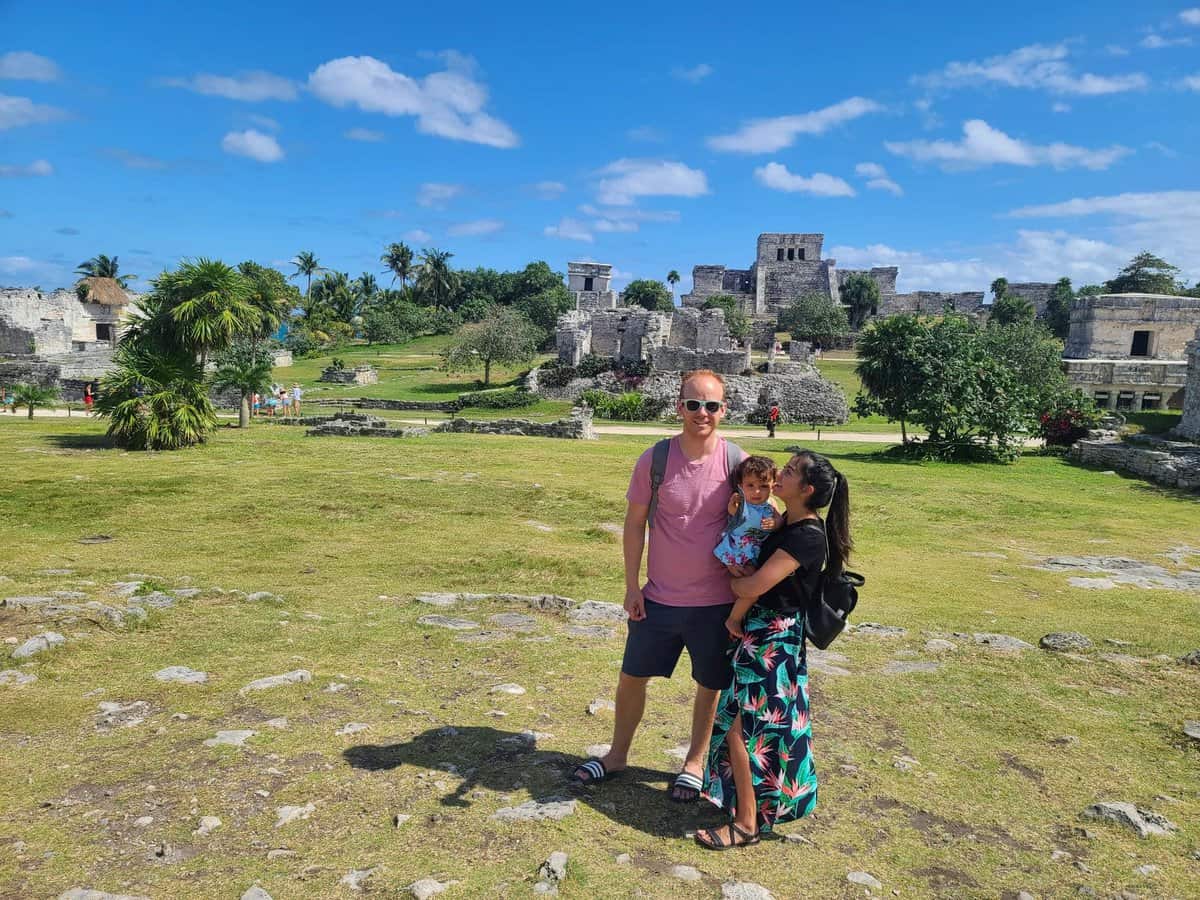
Getting to the Tulum Ruins
To reach the ruins, you have several options.
From Tulum Town:
- Tour: A hassle-free option, especially if you want to visit multiple Mayan ruins near Tulum.
- Taxi: The most convenient option from Tulum town center, costing approximately 150 MXN ($7.50 USD).
- Bicycle: A scenic and affordable option, taking around 10-15 minutes. Rental bikes are readily available in town, and parking is available at the ruins.
- Colectivo (Shared Van): The most budget-friendly choice, with frequent departures and a fare of around 60 MXN ($3 USD). Colectivos stop near the ruins entrance.
- Walking: While possible, it takes around 45-60 minutes and may not be ideal in hot weather.
- Driving: Parking is available for 120 MXN ($6 USD), but be prepared for a 10-15 minute walk to the ruins entrance.
From Cancun or Playa del Carmen:
- Rental Car: Offers flexibility and convenience for exploring the area. Parking is available at the ruins.
- Tour: A hassle-free option with transportation and a knowledgeable guide. Many tours combine Tulum with other attractions like cenotes or snorkeling.
- ADO Bus: ADO, the main bus company, operates direct routes from both Cancun and Playa del Carmen. Buses stop near the ruins entrance.
- Taxi: Although convenient, taxis are the most expensive option, costing 1,500-2,000 MXN ($75-$100 USD) or more from either city.
- Private Transfer: Companies like Happy Shuttle Cancun offer private transportation from Cancun Airport to Tulum, providing a personalized and comfortable experience.
Whichever option you choose, the stunning Tulum ruins are sure to be a memorable highlight of your trip to the Yucatan Peninsula.
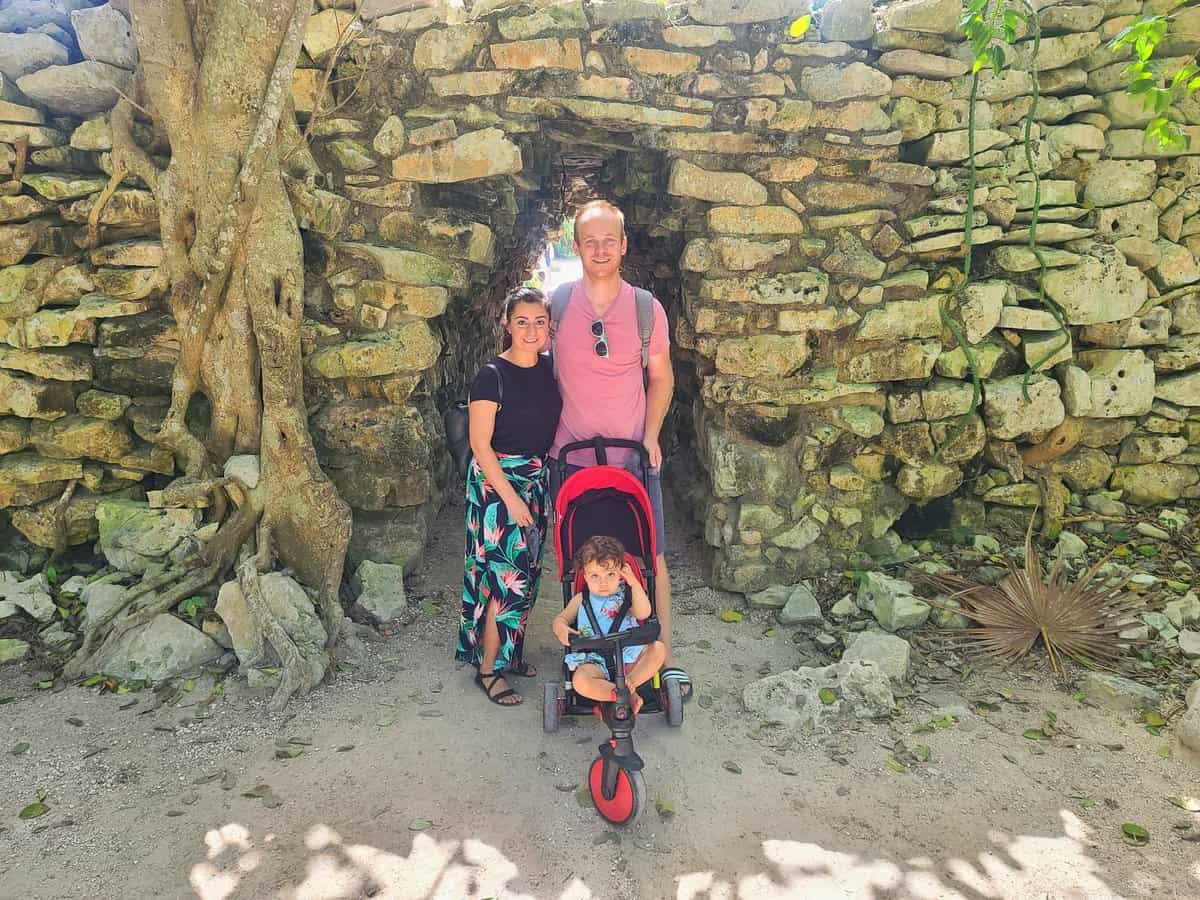
Tulum Archaeological Zone: Fees & Hours
To ensure a smooth visit to the Tulum ruins, it’s essential to understand the ticketing process.
Opening Hours & Best Times to Visit:
- Open daily: 8:00 am – 5:00 pm (last admission at 3:30 pm)
- Best times to visit: Early morning (8:00-10:00 am) or late afternoon (3:00-5:00 pm) to avoid crowds and heat.
Entrance Fees:
- Ruins entrance (INAH ticket): 95 pesos per person
- Tulum National Park (CONAP bracelet): 60 pesos per person (free for children under 12)
Both fees are mandatory with one exception: Mexico residents can visit the ruins for free on Sundays. This includes both Mexican citizens and foreign residents.
Important Notes:
- Sundays are the busiest day to visit Tulum ruins for the reason mentioned above.
- Bring cash in Mexican pesos, as the ruins do not accept US dollars, Euros, or credit/debit cards.
- Tickets can be purchased directly at the gate upon arrival. Do not buy tickets elsewhere to avoid scams.
- Optionally, you can take a Folkloric train to the entrance for 20 pesos per person if you don’t want to walk from the parking lot.
- Guided tours are available for those who want a more informative experience, costing 600-1500 MXN ($35-80 USD).
- As of 2024, bringing or operating drones in Mexico is prohibited for non-citizens.
- Wear light clothing, sunscreen, and drink plenty of water, as Tulum can get incredibly hot.
- Either bring your own water and snacks or buy them at the entrance as there are no vendors within the archaeological site.
- Exploring takes 1-2 hours. It’s a manageable walk, even with young children, but an umbrella for shade is wise.
- Don’t forget your swimsuit! Two nearby beaches, Playa Santa Fe and Playa Paraiso, offer a cool-down after your historical adventure.
If you’re planning to use a GoPro or other professional camera, there’s an additional fee of 45 MXN ($2.5 USD).
Most people report that cell phone cameras are exempt from this extra charge.
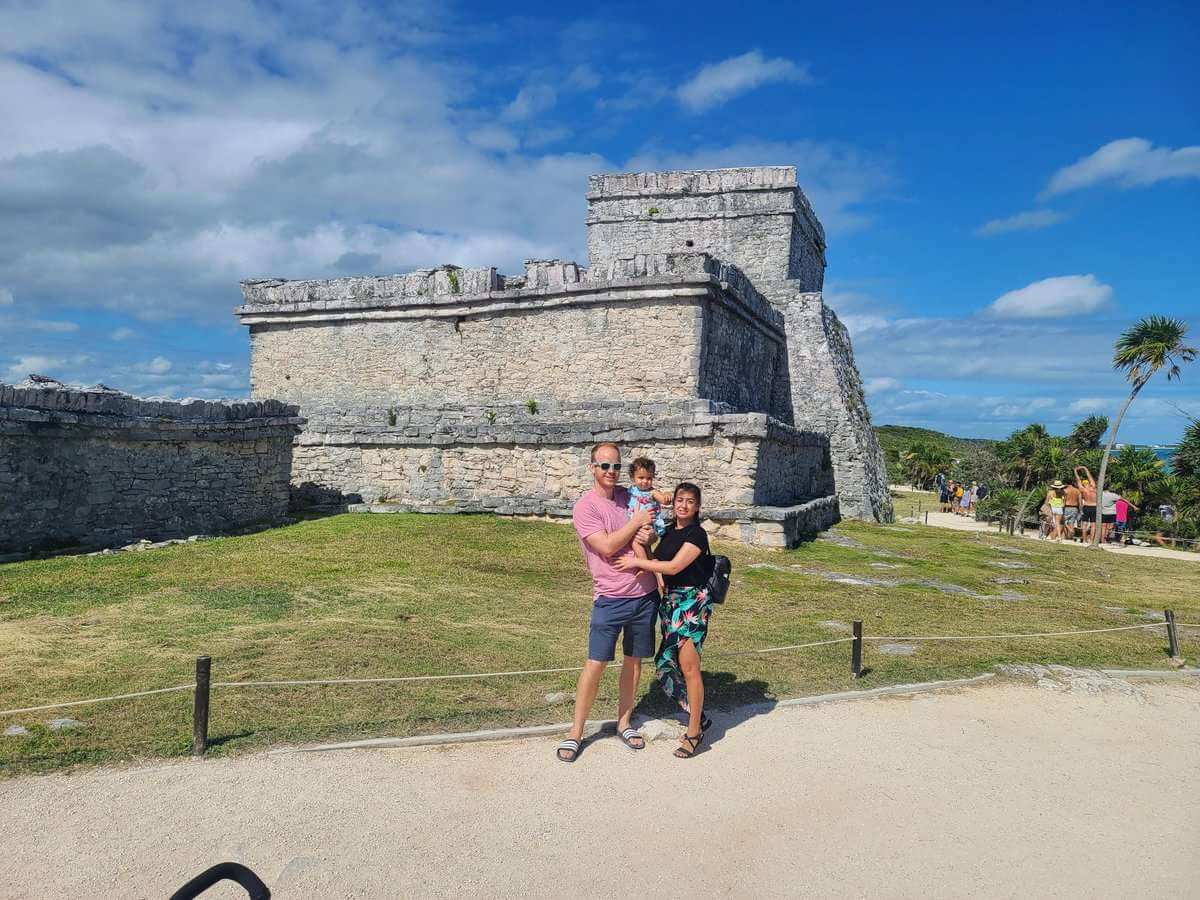
What to See at Tulum Mayan Ruins
Uniquely situated on the coast, Tulum ruins showcase over 60 restored structures and temples, many with balconies overlooking the ocean.
Be sure not to miss these impressive structures that highlight the Mayans’ architectural prowess:
- El Castillo (The Castle): This iconic structure served as both a temple and a lighthouse, guiding maritime trade. At 24 feet (7.3 meters) high, it stands as the tallest pyramid at the site.
- Temple of the Frescoes: This two-story temple is renowned for its well-preserved frescoes depicting Mayan deities and symbols. It was also used to track the sun’s movements, demonstrating the Mayans’ advanced astronomical knowledge.
- Temple of the Descending God: This temple is dedicated to the Mayan “diving god” deity, who is depicted in a downward diving position on the temple’s facade.
- House of the Columns (El Palacio): This large building complex with multiple rooms served as a residence for important Mayan leaders, showcasing the city’s social hierarchy and governance structure.
- The Wall: The imposing limestone wall that surrounds the city on three sides served as a protective barrier and a symbol of Tulum’s boundaries. The Mayan word “tulum” translates to “wall.”
Other Notable Structures:
- House of Halach Uinic
- Temple of the Wind God
- House of the Cenote
These structures played important roles in ceremonial and bureaucratic functions, contributing to the rich tapestry of life in ancient Tulum.
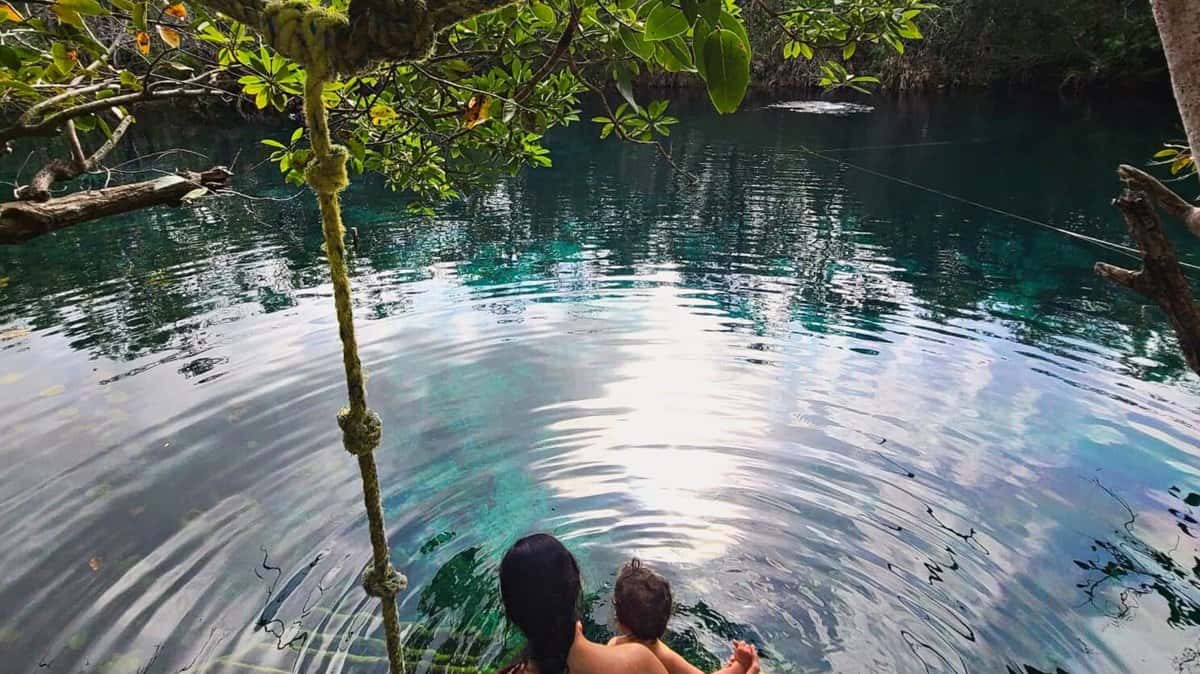
Nearby Attractions: Beyond the Tulum Ruins
Tulum offers beautiful beaches, resorts, and a wellness scene. Consider staying in Tulum town for affordable accommodations and a laid-back atmosphere.
Nearby activities include:
- Cenotes: Explore the natural wonders of the Yucatan Peninsula by visiting these underground sinkholes. Revered by the Mayans as sacred water sources, cenotes now offer incredible opportunities for swimming, snorkeling, and scuba diving. Some of our favorite cenotes near Tulum include Cenote Zacil Ha and Cenote Carwash.
- Adventure Parks: Thrill-seekers will delight in the nearby adventure parks, such as Xcaret, Xel-Ha, Xenses, and our top pick, Xplor. These parks offer a diverse range of activities, from snorkeling and ziplining to exploring underground rivers and caves.
Tulum’s central location in Quintana Roo state makes it an ideal base for exploring the Yucatan Peninsula.
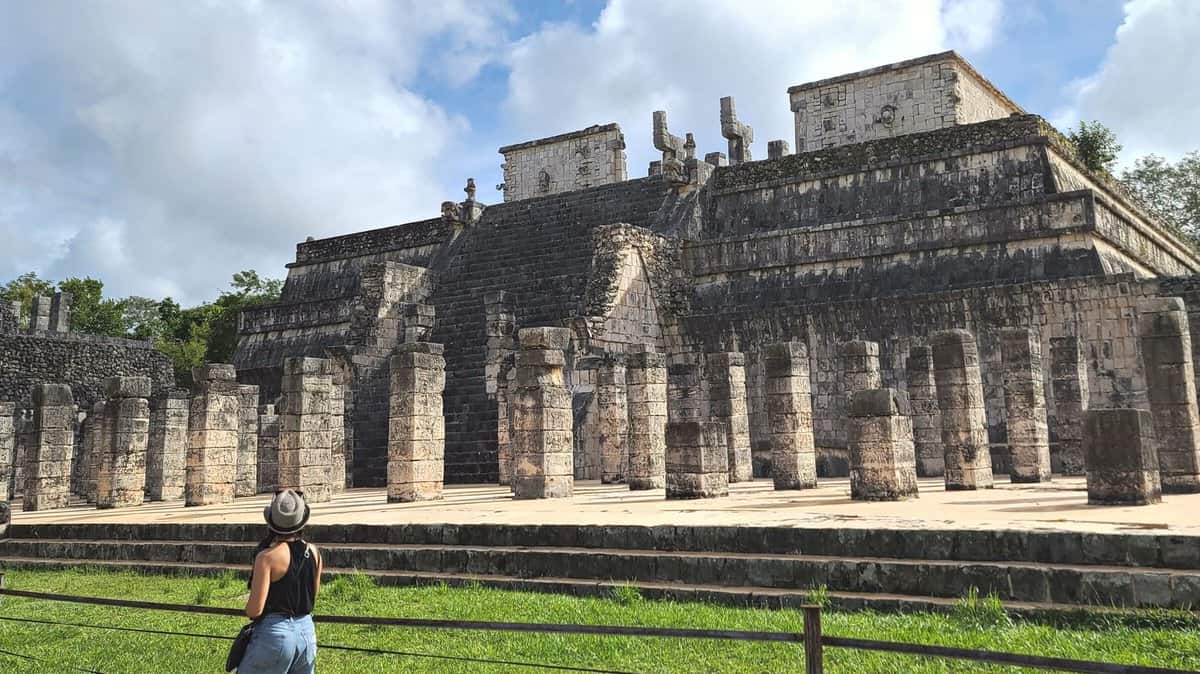
Which Mayan Ruins are the Best?
Quintana Roo is home to several remarkable Mayan ruins, each offering a unique glimpse into the rich history and culture of this ancient civilization.
Here are some of the best sites to explore near Tulum:
- Tulum Ruins: Well-preserved ruins perched on a cliff overlooking the Caribbean Sea, featuring El Castillo, the Temple of the Frescoes, and the Temple of the Descending God.
- Muyil (Chunyaxche): Reconstructed Castillo pyramid in the Main Plaza, a jungle trail leading to a lagoon, and a serene atmosphere away from the crowds.
- Coba: The largest and oldest ancient Maya site in Quintana Roo, featuring the tallest pyramid on the Yucatan Peninsula (Nohuch Mul), ball courts, and stelae scattered along jungle pathways.
- Chichen Itza: A UNESCO World Heritage Site and one of the New 7 Wonders of the World, Chichen Itza boasts iconic structures like El Castillo (the Pyramid of Kukulcan), the Temple of the Warriors, and the Great Ballcourt.
Though not in Quintana Roo, Chichen Itza is a must-visit Mayan site located about 3 hours west of Tulum in the neighboring state of Yucatan.
To visit both Tulum and Coba ruins in a day, start early (around 7:00-8:00 am) and allocate at least 2-3 hours at each site. Consider a guided tour for a hassle-free experience, or plan your route and timing carefully if exploring independently.
Choosing Your Adventure:
- Tulum Ruins: Ideal for a quick and easily accessible visit, offering stunning coastal views and well-preserved structures.
- Muyil: Perfect for nature lovers and those seeking a more tranquil experience, with opportunities for hiking and exploring the lagoon.
- Coba: Recommended for those who want to delve deeper into Mayan history and explore a larger, more spread-out site.
- Chichen Itza: A must-visit for any history enthusiast, offering a grand showcase of Mayan architecture and cultural significance. While further away, it’s worth the journey for its iconic structures and grandeur.

Tulum vs. Chichen Itza
Both Tulum and Chichen Itza offer remarkable glimpses into the rich history and culture of the Maya civilization. The “better” choice depends on your personal preferences and travel goals.
Tulum: The Perfect Choice If…
- You’re short on time: Tulum’s compact layout makes it ideal for a shorter visit.
- You’re based in Tulum: The ruins are right within the town, minimizing travel time.
- You want a taste of Mayan culture: While smaller than Chichen Itza, Tulum still provides a fascinating introduction to Mayan architecture and history.
- You crave stunning scenery: Tulum’s clifftop location offers breathtaking views of the Caribbean Sea.
Chichen Itza: The Ideal Destination If…
- You seek a deeper experience: As one of the New 7 Wonders of the World, Chichen Itza delves deeper into Mayan history and culture, with more extensive ruins to explore.
- You’re willing to dedicate a full day: Tours from Cancun or Playa del Carmen typically last around 11 hours.
- You want to see a world-famous landmark: Chichen Itza’s iconic pyramid, El Castillo, is a must-see for many travelers.
If you can only visit one site, consider these factors:
- Time: How much time do you have for exploration?
- Location: How far are you willing to travel from your accommodations?
- Interests: Are you more drawn to coastal views (Tulum) or jungle surroundings (Chichen Itza)?
- Priorities: Is seeing a World Wonder a top priority for you?
If time allows, we highly recommend visiting both Tulum and Chichen Itza. Each site offers a unique and unforgettable experience.
We’d love to hear about your experiences and comparisons in the comments below! Have you explored other Mayan ruins as well? Share your stories with us!

Visiting Tulum Ruins FAQ
Are the Tulum ruins worth visiting?
Yes, yes, and another big YES! The Tulum Ruins are a great choice for those who are staying in or near Tulum.
Does Tulum have pyramids?
Tulum does not have traditional pyramids like those found in Chichen Itza. However, it does have the Castillo, a large structure that served as a watchtower and is the tallest building in the site.
Can you still climb Tulum ruins?
Climbing on the ruins is no longer permitted to preserve the site.
Do you need sneakers for Tulum ruins?
Comfortable walking shoes are recommended for exploring the Tulum ruins.
Is there a dress code for Tulum ruins?
There is no official dress code, but it is advisable to dress respectfully and wear comfortable clothing suitable for the warm weather.
Can you swim near Tulum ruins?
Yes, there is a beach below the Tulum ruins where you can swim.
Can you see Tulum ruins from the beach?
Yes, the Tulum ruins are perched on a cliff overlooking the beach, offering a unique view from the shoreline.
Who lived in the Tulum ruins?
The Tulum ruins were once a major port city inhabited by the Maya people.
Are Tulum ruins and Chichen Itza the same?
No, they are distinct Mayan archaeological sites. Chichen Itza is larger and located further inland, while Tulum is smaller and situated on the coast.
Which is older, Chichen Itzá or Tulum?
Chichen Itza is older, dating back to the Late Classic Period (600-900 AD), while Tulum was built during the Post Classic Period (1200-1550 AD).
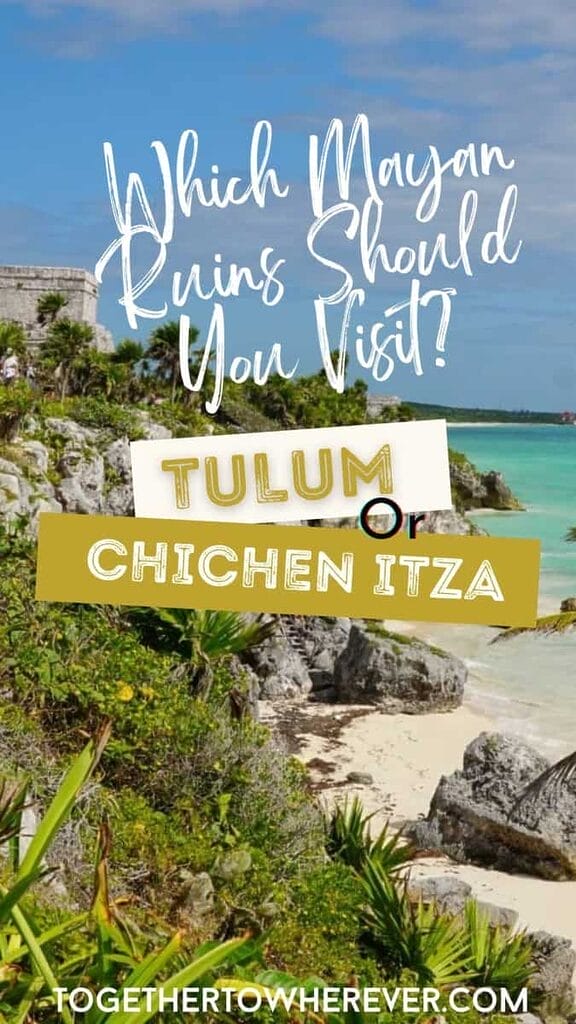


Leave a Reply